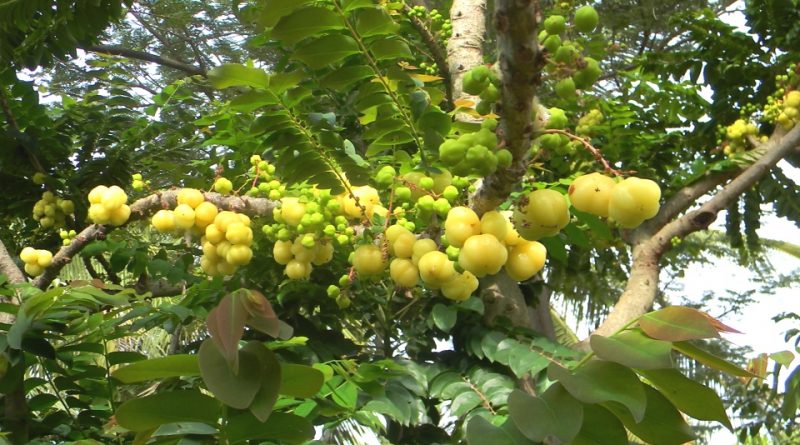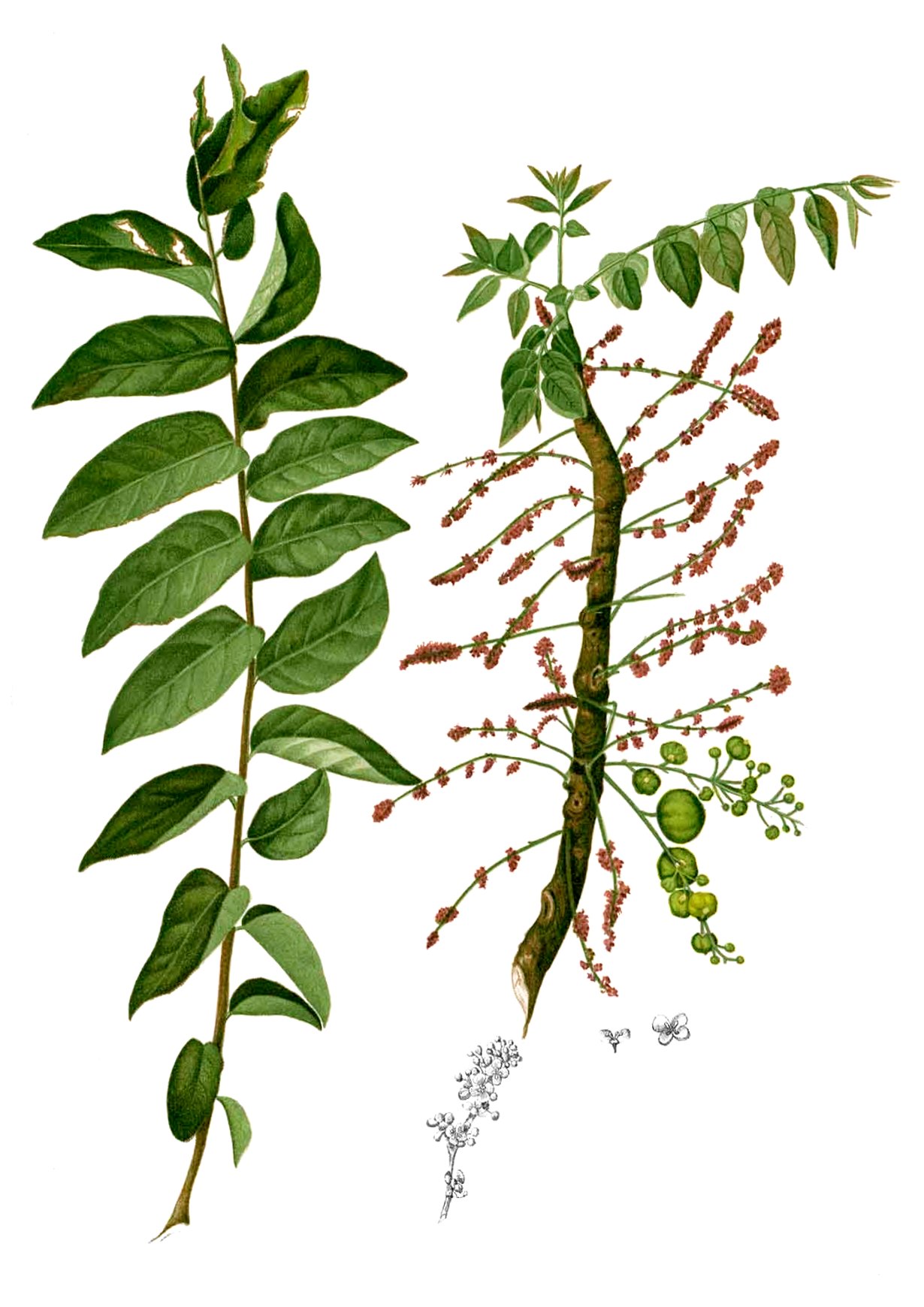Phyllanthus acidus
Phyllanthus acidus
The Otaheite gooseberry or Malay gooseberry, Tahitian gooseberry, country gooseberry, star gooseberry, starberry, arbari, West India gooseberry, gooseberry tree (Phyllanthus acidus (L.) Skeels) is an arboreal species belonging to the Phyllanthaceae family.
Systematic –
From a systematic point of view it belongs to:
Eukaryota domain,
Kingdom Plantae,
(clade) Angiosperms,
(clade) Mesangiosperms,
(clade) Eudicotyledons,
(clade) Central Eudicotyledons,
(clade) Superrosides,
(clade) Rosids,
(clade) Eurosids,
(clade) COM,
Malpighiales Order,
Phyllanthaceae family,
Genus Phyllanthus,
Species P. acidus.
The term is basionym:
– Averrhoa acida L.
The terms are synonymous:
– Averrhoa frondosa Salisb.;
– Cicca acida (L.) Merr.;
– Cicca acidissima Blanco;
– Cicca acidua (L.) Merr.;
– Cicca disticha L.;
– Cicca nodiflora Lam.;
– Cicca racemosa Lour.;
– Diasperus acidissimus (Blanco) Kuntze;
– Phyllanthus acidissimus (Blanco) Müll.Arg.;
– Phyllanthus cicca Müll.Arg.;
– Phyllanthus cicca subsp. bracteosa Müll.Arg.;
– Phyllanthus cicca var. bracteosa Müll.Arg.;
– Phyllanthus cochinchinensis (Lour.) Müll.Arg.;
– Phyllanthus distichus (L.) Müll.Arg.;
– Phyllanthus distichus f. nodiflorus (Lam.) Müll.Arg.;
– Phyllanthus distichus subsp. nodiflorus (Lam.) Müll.Arg.;
– Phyllanthus longifolius Jacq.;
– Tricarium cochinchinense Lour..
Etymology –
The term Phyllanthus comes from the Greek terms “phyllon”, i.e. leaf and “anthos”, i.e. flower, in reference to the flowers which in some species belonging to the genus arise on flat stems (cladodes) similar to leaves.
The specific epithet acidus comes from the Latin “acidus”, i.e. acid in reference to the decidedly acidic flavor of the fruits.
Geographic Distribution and Habitat –
Phyllanthus acidus is a plant whose origin is uncertain, however it may have originated in Madagascar. It was found early in other parts of South Asia; according to Eduardo Quisumbing it was brought to the Philippines in prehistoric times. It spread across the Indian Ocean to Réunion Island and Mauritius and crossed the Pacific to Hawaii. It expanded to the Caribbean in 1793, when William Bligh brought the plant from Timor to Jamaica.
This tropical or subtropical species is found throughout Asia and also in the Caribbean region, Central and South America.
In detail, the tree is common in Guam, Micronesia, South Vietnam, Laos, northern peninsular Malaysia, India, West Bengal and Bangladesh and in Marathi. It is still found in the Philippines and, if not widely, in Cambodia and Thailand.
In the United States, it is found in Hawaii and occasionally in the southern parts of Texas, Florida. It is also found in Puerto Rico, Ecuador, El Salvador, Nicaragua, Mexico, Colombia, Venezuela, Guyana, Suriname, the US Virgin Islands, Peru and Brazil.
Its habitat is that of coastal forest formations, arid woods and on calcareous soils.
Description –
Phyllanthus acidus is a plant that grows in the form of a shrub or small deciduous tree up to about 8 m tall.
The trunk at the base measures 15 to 18 cm in diameter, with greenish-grey, fissured bark.
The foliage is dense, made up of bare gnarled branches with groups of rather thin branches at the apex, up to 30 cm long, bearing alternate elliptical leaves with pointed apex, slightly shiny green above, bluish green below.
The leaves are up to 7 cm long, are placed on a short petiole, and arranged in two rows giving the impression of a single compound leaf.
The flowers, male, female and sometimes hermaphroditic, are gathered together in compound racemes, 6-12 cm long, which arise in the terminal part of the branches without leaves, rarely in the axils of the leaves, they are small, 3-5 mm in diameter , and reddish.
The fruits are numerous and compact, very showy overall, they are waxy, rounded, with a diameter of 1-2.5 cm, slightly flattened above and below, green or pale yellow in color when ripe, and have 6-8 prominences longitudinal; the pulp (mesocarp) is watery and decidedly acidic, the endocarp is hard with three cells inside, generally containing two seeds each.
Cultivation –
Phyllanthus acidus is a plant that is occasionally grown as a garden species in tropical areas for its fruits and as an ornamental plant.
It grows well in the tropics at low and medium altitudes in places with a short or prolonged dry season. It prefers hot and humid tropical plains. It flowers from sea level up to an altitude of 1,500 – 1,800 metres.
It should be noted that the temperature range for growth is between 14 and 35 °C, with an optimal value between 20 and 29 °C.
The annual rainfall range for growth is estimated to be between 700 and 4,200 mm, with an optimum between 1,500 and 2,500 mm.
It requires a position in full sun or partial shade, but is not demanding regarding soil needs. It grows well in arid areas but prefers to grow in a moist site, although established plants are drought tolerant.
It is a widely cultivated fruit and ornamental plant, the plant sometimes escapes cultivation and becomes naturalized. According to some reports it can become invasive.
The seedlings grow quickly and can bear fruit as early as 2 – 3 years.
The plant can flower and produce fruit most of the year, although there are generally two periods per year when fruit is produced in abundance.
The flowers are borne in clusters composed of male, female or hermaphroditic flowers.
The fruits often open explosively, dispersing their seeds.
Furthermore, since the fruit does not soften when ripe, it is harvested when it begins to fall.
The fruit is sometimes sold in local markets.
The plant generally reproduces by seed, which germinates within one to four months, with the first fruiting occurring between the second and fourth year of age, but also by non-lignified cutting, with rather slow rooting, and layering.
Customs and Traditions –
Phyllanthus acidus is a plant known by many local names; among these are: country gooseberry, damsel, gooseberry tree, indian gooseberry, malay gooseberry, otaeithe gooseberry, sour cherry, star gooseberry, tahitian gooseberry (English); cerisier de Tahiti, cherimbillier, pomme-surelle, surelle, surette (French); cerejeira-do-Tahiti (Portuguese); cereza amarilla, cerezo agrio, ciruela corteña, grosella, grosellero, guinda, manzana-estrella (Spanish); stachelbeerbaum (German).
Different parts of the plant are used for food. In Bangladesh, India and Indonesia the cooked leaves are eaten. Although the fruit is eaten fresh and is sometimes used as a condiment for other dishes in Indonesia, it is generally considered too acidic to be eaten alone in its natural form and is further processed. It is candied in sugar or marinated in salt, used in chutney, relish or preserves. In the Philippines it is used to make vinegar and eaten raw, soaked in salt or salt and vinegar solution and sold roadside. It is also candied, usually stored in jars with syrup. In Malaysia they turn them into a syrup. Freely sweetened, it is also used to prepare fruit juices. In Thailand it is used as an ingredient to prepare Som tam, to prepare pickles, boil them in syrup (Ma-Yom Chuam).
Furthermore, the plant is also used medicinally. The peppery leaves are used to prepare a poultice to treat sciatica, lumbago and rheumatism (but have been observed to cause lower blood pressure when combined with nitrates), while the seeds are used as a cathartic and the root, if carefully prepared, as a purgative. The syrup is used to medicate the stomach and in India the fruit is consumed as a blood enhancer for the liver; a lehyam, nellikai lekiyam, for which the salient ingredient is gooseberry fruit, is offered to children to boost their immunity.
Other uses include that although the wood is strong and durable if treated properly, the tree is not large and is rarely harvested for lumber. If collected it is used for small objects such as tools. In India, the root bark is sometimes used as a tanning agent.
Furthermore, the juice of the root bark is slightly poisonous.
The plant, from a phytochemical point of view, contains 4-hydroxybenzoic acid, caffeic acid, adenosine, kaempferol and hypogallic acid.
Preparation Method –
Phyllanthus acidus is a plant that is used mainly in the food and medicinal fields.
The fruits are eaten raw or cooked.
Ripe fruits can be eaten fresh but are usually sprinkled with salt to neutralize the acidity. They are rich in vitamin C with a very acidic flavour, and are most often used in condiments or chutneys, or cooked as a condiment in desserts.
The fruit is sometimes used as a substitute for tamarind.
The leaves are cooked as vegetables and have a neutral or delicate flavor, but somewhat fibrous.
In the medicinal field the root is used as an active purgative.
An infusion of the root is taken to relieve asthma.
An extract of the root is used to treat skin diseases, especially to relieve itching.
The leaves are used as one of the ingredients in a Thai remedy to control fever.
A decoction of leaves is applied to urticaria.
An infusion of the leaves is used as a dietary aid for people who are on a diet and wish to stay slim.
Emetic and purgative activities are attributed to latex.
The bark is heated with coconut oil and smeared on the rashes on the feet and hands.
A decoction of the bark is used to treat bronchial catarrh.
The fruits are used as laxatives and are also taken as a liver tonic to enrich the blood.
The juice of the fruit is instilled in the eyes to cure eye disorders.
Seeds are cathartic.
Among other uses, the bark is reported to be used in India as a tanning agent.
An extract of the plant showed nematicicidal activity against the pine wood nematode, Bursaphelenchus xylophilus.
Guido Bissanti
Sources
– Acta Plantarum – Flora of the Italian Regions.
– Wikipedia, the free encyclopedia.
– GBIF, the Global Biodiversity Information Facility.
– Useful Tropical Plants Database.
– Conti F., Abbate G., Alessandrini A., Blasi C. (ed.), 2005. An annotated checklist of the Italian vascular flora, Palombi Editore.
– Pignatti S., 1982. Flora d’Italia, Edagricole, Bologna.
– Treben M., 2000. Health from the Lord’s Pharmacy, Advice and experiences with medicinal herbs, Ennsthaler Editore.
Photo source:
– https://inaturalist-open-data.s3.amazonaws.com/photos/134249305/original.jpeg
– https://upload.wikimedia.org/wikipedia/commons/e/ed/Phyllanthus_acidus_Blanco2.303-cropped.jpg
Attention: Pharmaceutical applications and food uses are indicated for informational purposes only, they do not represent in any way a medical prescription; we therefore decline any responsibility for their use for healing, aesthetic or food purposes.


